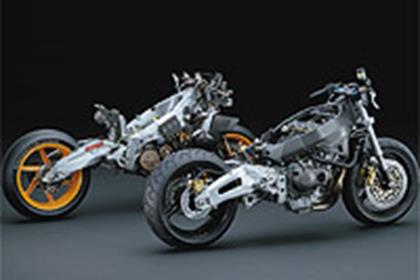First official pictures of the 2002 Blade
As spyshots revealed on motorcyclenews.com in June, the FireBlade has undergone a visual makeover for 2002 which includes a host of other components have been altered to make this the sharpest Blade yet.
The most significant modification is to the motor. In 2000 Honda tried to combat the threat of Yamaha’s R1 by upping the capacity by 11cc to 929cc. The 2002 Blade not only has a new R1 to take on, but the class-leading GSX-R1000, so Honda has responded by boring out the motor again. The 2002 bike is the biggest Blade yet, with a capacity of 954cc.
According to sources at Honda, this is as far as the current motor will go without compromising reliability – a Honda strong point. To reach this capacity the bore has been increased by 1mm to 75mm while the stroke remains at 54mm. New lighter and shorter pistons run in the cylinders.
These changes should make the motor faster revving as the pistons have less inertia, which road riders should notice with faster throttle response and crisper acceleration. Racers will find the motor more reliable as the new pistons will put less stress on the con-rod when the bike is on over-run.
Frank Wrathall, the tuner who helped create the 954cc racing FireBlade for the cancelled 2001 TT, which MCN tested in July, reckons road riders are in for a treat.
He said: ” It will have more power everywhere. I would expect a 6bhp gain through the rev range, giving it more mid-range as well as top end. Torque will probably be up between 6 and 8ftlb. ”
Honda isn’t so optimistic. It claims a 3bhp increase to 149bhp, with torque up to 77ftlb at 9500rpm, up around 3ftlb. That will be enhanced by the firm’s H-VIX system, carried over from the previous model. Similar to Yamaha’s Exup valve, it opens and shuts to control the flow of pressure waves out of the pipe, giving the engine a kick in the mid-range. A lightweight titanium end can also contributes to the power boost.
There are only slight mods to the frame – hardly surprising as the current bike is already regarded as the most neutral-handling in its class. Sub-frame mounting points have been moved further up the frame, and the whole thing is painted black, following the trend set by the CBR600F Sport.
The swingarm, however, is totally new. In response to racers’ comments that there was too much flex in the 2001 bike’s box-section arm, Honda has redesigned it completely. It now has more bracing as well as weight-saving holes to give the suspension an easier time.
Honda will still mount the swingarm directly on to the engine, making it a stressed member. This removes the need for a swingarm pivot, but the pivot casting has been redesigned to make it lighter and stronger.
The shock has been modified slightly to work with this set-up, but it’s the same piggyback unit used in the 2001 bike, with a yellow spring instead of the white one. A rear hugger helps keep it that colour. The 43mm inverted forks are unchanged.
The chassis changes have shaved 2kg (4.4lb) off the weight – taking it to just 168kg (370lb).
As well as the performance-enhancing changes, a glance at the pictures on this page will reveal plenty of visual tweaks, too – the new Blade has an even more aggressive look, thanks to a totally new fairing and seat unit.
The new lights are narrower than the previous bike’s, making the front pointier and sportier. The new fairing should boost comfort as well as looks, as the screen is an inch taller than the 2001 Blade’s, and more steeply angled to deflect more wind over the rider’s head. Touring on a Blade, anyone.
The main fairing is now a single piece, which adds to the streamlined look. It also extends farther back to hide more of the clutch cover.
The fuel tank is sculpted to provide more knee room and is slightly shorter than the previous bike’s. This lets you put more weight over the front, a position encouraged by a flatter-angled seat.
The seat is also more aggressively styled and tapers off to a sharper point. It’s similar to the one on the CBR600F Sport, which means the pillion’s head is still well above the rider’s – that is, if you can persuade a pillion to get on without a grabrail to hang on to.
Tail-lights are futuristic-looking LEDs – a first on a Honda, but already used on the R6 and expected on the 2002 R1.
The digital speedo, clock and two trips stay, but the whole dash has been restyled to give it a cleaner look. And with the new Blade likely to be just as nickable as the current bike, you’ll be glad of the HISS logo next to the ignition, which means it will come with Honda’s own immobiliser.
The bike will be available in three colours – red/black, white/blue and blue/yellow – and is expected to go on sale at Christmas for around £8699, the same as the current model.


